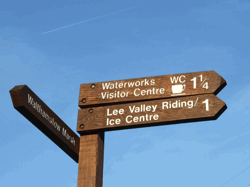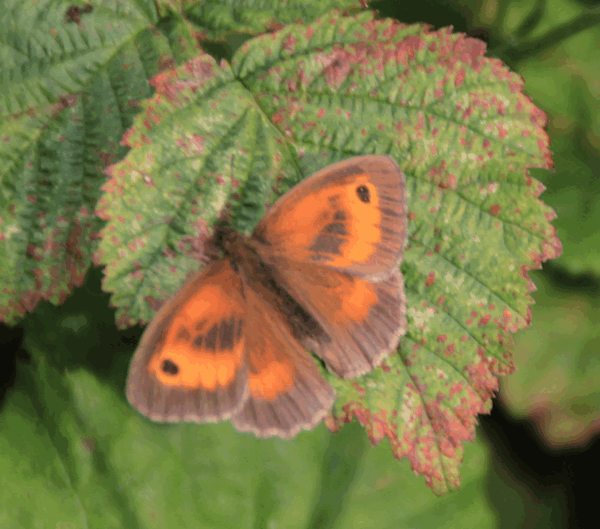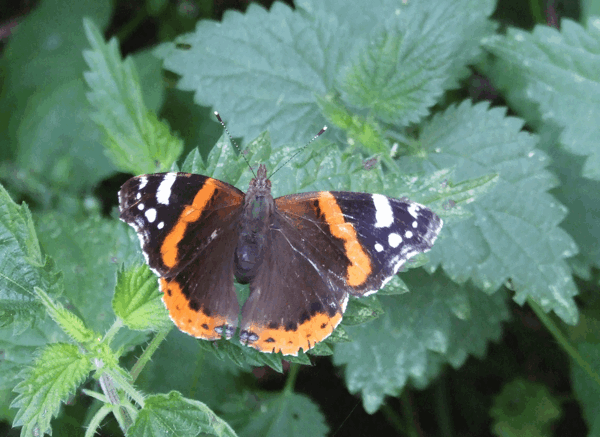 |
|
| |||||
THE BUTTERFLIES OF WALTHAMSTOW MARSHES | |||||
|
The following 17 species of Butterfly all breed regularly in the area. The occasional passing Holly Blue and migrant Clouded Yellow have also been observed. 300 years ago, the Swallowtail Butterfly bred here, a species now protected in Wicken Fen and the Norfolk Broads only. | |||||

| The Gatekeeper butterfly visits Lea Marsh but was not amongst the 17 original catalogued. | 
| |||
| Wall Brown | Frequent in short grassland, on paths, and, in early morning sunshine, basking on railway bridge walls. Caterpillars eat grasses. | ||||
| Meadow Brown | Common in tall pasture and dry grassland. Caterpillars eat grasses. | ||||
| Small Heath | Common in short grassland and along paths. Caterpillars eat grasses. | ||||
Red Admiral | Occasional on Thistle and Michaelmas Daisy flowers. Caterpillars eat nettles. | ||||
| Peacock | Occasional on Thistle and Michaelmas Daisy flowers. Caterpillars eat nettles . | ||||
| Small Tortoiseshell | As above again, but much commoner, especially in late Summer. | ||||
| Painted Lady | Occasional. Caterpillars eat Thistles . | ||||
| Comma | Occasional. Caterpillars eat Wild Hop. | ||||
| Common Blue | Quite common in dry grassland. Caterpillars eat Clovers and Trefoils. | ||||
| Small Copper | Quite common. Caterpillars eat Sheep's Sorrel only. | ||||
Large White | Common. Caterpillars in the wild eat Horse-radish, and Turnip, rather than cabbage, | ||||
| Small White | Common. Caterpillars eat Turnip and Hedge Mustard. | ||||
| Green-veined White | Very common. A more rural species than the last two. Same food plants. | ||||
| Orange Tip | Scarce. Possibly dependant entirety on the small Jack-by-the-Hedge colony alongside the marina for the survival of its caterpillars. | ||||
| Small Skipper | Quite frequent in tall grassland. Caterpillars eat Yorkshire Fog and Timothy Grasses. | ||||
| Essex Skipper | This is the speciality of the area, and its main joy during midsummer, when the butterflies are numerous on Thistle, Knapweed, and other Composite flowers. Discovered in Britain only in 1890, this is basically a Continental species which occurs here on the extreme north-edge of its entire world range. It is found in East Anglia and the South-East of England only. The Walthamstow colony is strong, but very isolated, and the nearest to Central London, so is particularly worthy of preservation. Foodplant is Couch Grass in relatively dry grassland which Comfreys and Hogweeds have not too much encroached into. | ||||
| Large Skipper | Quite frequent in slightly coarser vegetation than the last. Flies 3-4 weeks earlier than the other two Skippers. Foodplant Cock's-Foot Grass. | ||||
The Butterfly Habits and Seasons at Walthamstow
Granted favourable weather conditions, butterflies have been observed on the wing during every month from February to November. In early Spring, the Small Tortoiseshells awake from hibernation, followed in April by the emergence of the Whites. May is a good month for Orange Tips, with Walls, Small Coppers, and Common Blues enjoying their first generation in the shorter grassland. The Whites increase in June, with the beginning of Large Skippers and first-generation Small Tortoiseshells. July and early August provide the climax of the butterfly year, with a continuation of the above reinforced by large numbers of Meadow Browns, and Essex Skippers.
On sunny days, parts of the Marshes may swarm with these species mixtures, dramatically contradicting popular current belief that butterflies in general are on the verge of extinction in Britain! The grassland species steadily decline from mid-August onwards, and the remainder of the Autumn sees the Whites and the Vanessids alone patronising the Cruciferae and the Compositae respectively (Vanessids are Small Tortoiseshell, Red Admiral, Peacock, Comma, Painted Lady, and are our most colourful British group of butterflies).
The Vital Importance of the Walthamstow Grassland
This importance is clearly proven by the numbers of butterflies whose caterpillars are shown above to depend on it absolutely for their food. Grass-feeders are unable to eat any other plants. Moreover, these grass-feeders remain on the Marshes as adult butterflies, and they would be totally exterminated by a digging operation which destroyed those particular species of grass, for my "Notes on the Habitats" describe how disturbed ground changes the flora. By contrast, the Vanessid butterflies depend on Nettles, Thistles and Wild Hop, as shown above. In these cases, the adult butterflies do not restrict themselves to the Marshes. They are strong flyers, and they distribute themselves widely over all the surrounding areas, to beautify the Composite and Sedum flowers of our gardens and parks in midsummer.
It has to be understood that these flowers themselves cannot support these butterfly species; they only refresh the adults. The caterpillar foodplants are clearly species of plants which could not be allowed to occupy gardens and parks to any significant degree. Therefore the plentiful supply of them on the Marsheses represents a vital foodplant reserve, which, if destroyed would see the end of nearly all the colourful butterflies throughout an extensive expanse of East London.